A Study of the Characteristics of Plasma Generated by Infrared Pulse Laser-Induced Fused Silica
Abstract
:1. Introduction
2. Materials and Methods
3. Principle of the Experiment
4. Results and Discussion
4.1. Analysis of the Plasma Temperature Field Induced by a Pulsed Laser in Fused Silica
4.2. Analysis of the Plasma Flow Field in Fused Silica Induced by a Pulsed Laser
5. Conclusions
- (1)
- The temperature field mainly discussed the relationship of temperature distribution in the radial position over time. The simulation results showed that the temperature in the center region irradiated by the laser was the highest, and plasma was first generated in this region.
- (2)
- In the velocity field, the plasma flow field under different laser energy densities and pulse widths were analyzed and studied, and the relationship between the plasma expansion law and the laser energy density and pulse width were obtained. The simulation results showed that there was a large gap between the axial plasma expansion speed and the radial plasma expansion speed; the plasma expansion speed increased with the increase in the laser energy density and decreased with the increase in the pulse width. The simulation results were in good agreement with the experimental results, and it also provided a theoretical and experimental basis for studying the laser-induced plasma process of fused silica materials.
Author Contributions
Funding
Institutional Review Board Statement
Informed Consent Statement
Data Availability Statement
Acknowledgments
Conflicts of Interest
References
- Zhuang, S.; Kainuma, S.; Yang, M.; Haraguchi, M.; Asano, T. Characterizing corrosion properties of carbon steel affected by high-power laser cleaning. Constr. Build. Mater. 2021, 274, 122085. [Google Scholar] [CrossRef]
- Schneider, F.; Wolf, N.; Petring, D. High Power Laser Cutting of Fiber Reinforced Thermoplastic Polymers with cw- and Pulsed Lasers. Phys. Procedia 2013, 41, 415–420. [Google Scholar] [CrossRef]
- Ohnishi, T.; Kawahito, Y.; Mizutani, M.; Katayama, S. High-Power and High-Brightness Laser Butt Welding with Using Hot Wire for Thick High-Strength Steel Plate. Q. J. Jpn. Weld. Soc. 2011, 29, 41–47. [Google Scholar] [CrossRef] [Green Version]
- Wu, J.; Zhang, H.; Li, Y.; Zhong, Q. Numerical analysis of mass distribution in side shielding gas in laser welding. HanjiXuebao/Trans. China Weld. Inst. 2018, 39, 39–43. [Google Scholar]
- Kotz, F.; Quick, A.S.; Risch, P.; Martin, T.; Hoose, T.; Thiel, M.; Helmer, D.; Rapp, B.E. Two-Photon Polymerization of Nanocomposites for the Fabrication of Transparent Fused Silica Glass Microstructures. Adv. Mater. 2021, 33, 2006341. [Google Scholar] [CrossRef] [PubMed]
- Yoshida, H.; Fujita, H.; Nakatsuka, M.; Yoshida, K. High Resistant Phase-conjugated Stimulated Brillouin Scattering Mirror Using Fused-silica Glass for Nd:YAG Laser System. Jpn. J. Appl. Phys. 1999, 38, L521–L523. [Google Scholar] [CrossRef]
- Kozlowski, M.R.; Thomas, I.M.; Campbell, J.H.; Rainer, F. High-power optical coatings for a megajoule-class ICF laser. In Proceedings of the SPIE, Berlin, Germany, 14–19 September 1992; pp. 105–119. [Google Scholar]
- Wang, B.; Dai, G.; Zhang, H.; Ni, X.; Shen, Z.; Lu, J. Damage performance of TiO2/SiO2 thin film components induced by a long-pulsed laser. Appl. Surf. Sci. 2011, 257, 9977–9981. [Google Scholar] [CrossRef]
- Hopper, R.W.; Ublmann, D.R. Mechanism of inclusion damage in laser glass. J. Appl. Phys. 1970, 41, 4023–4037. [Google Scholar] [CrossRef]
- Bonneau, F.; Combis, P.; Rullier, J.L.; Vierne, J.; Pellin, M.; Savina, M.; Broyer, M.; Cottancin, E.; Tuaillon, J.; Pellarin, M.; et al. Study of UV laser interaction with gold nanoparticles embedded in silica. Appl. Phys. B 2002, 75, 803–815. [Google Scholar] [CrossRef]
- Bonneau, F.; Combis, P.; Rullier, J.L.; Vierne, J.; Bertussi, B.; Commandre, M.; Gallais, L.; Natoli, J.Y.; Bertron, I.; Malaise, F.; et al. Numerical simulations for description of UV laser interaction with gold nanoparticles embedded in silica. Appl. Phys. B 2004, 78, 447–552. [Google Scholar] [CrossRef]
- Courtois, M.; Carin, M.; Le Masson, P.; Gaied, S.; Balabane, M. A new approach to compute multi-reflections of laser beam in a keyhole for heat transfer and fluid flow modelling in laser welding. J. Phys. D Appl. Phys. 2013, 46, 505305. [Google Scholar] [CrossRef]
- Ranjbar, O.A.; Lin, Z.; Volkov, A.N. One-dimensional kinetic simulations of plume expansion induced by multi-pulse laser irradiation in the burst mode at 266 nm wavelength. Vacuum 2018, 157, 361–375. [Google Scholar] [CrossRef]
- Ji-Xing, C.; Ming, G.; Xu, Q.; He, L.; Guang-Yong, J. Gas dynamics and combustion wave expanding velocity of laser induced plasma. Acta Phys. Sin. 2017, 66, 094202. [Google Scholar] [CrossRef]

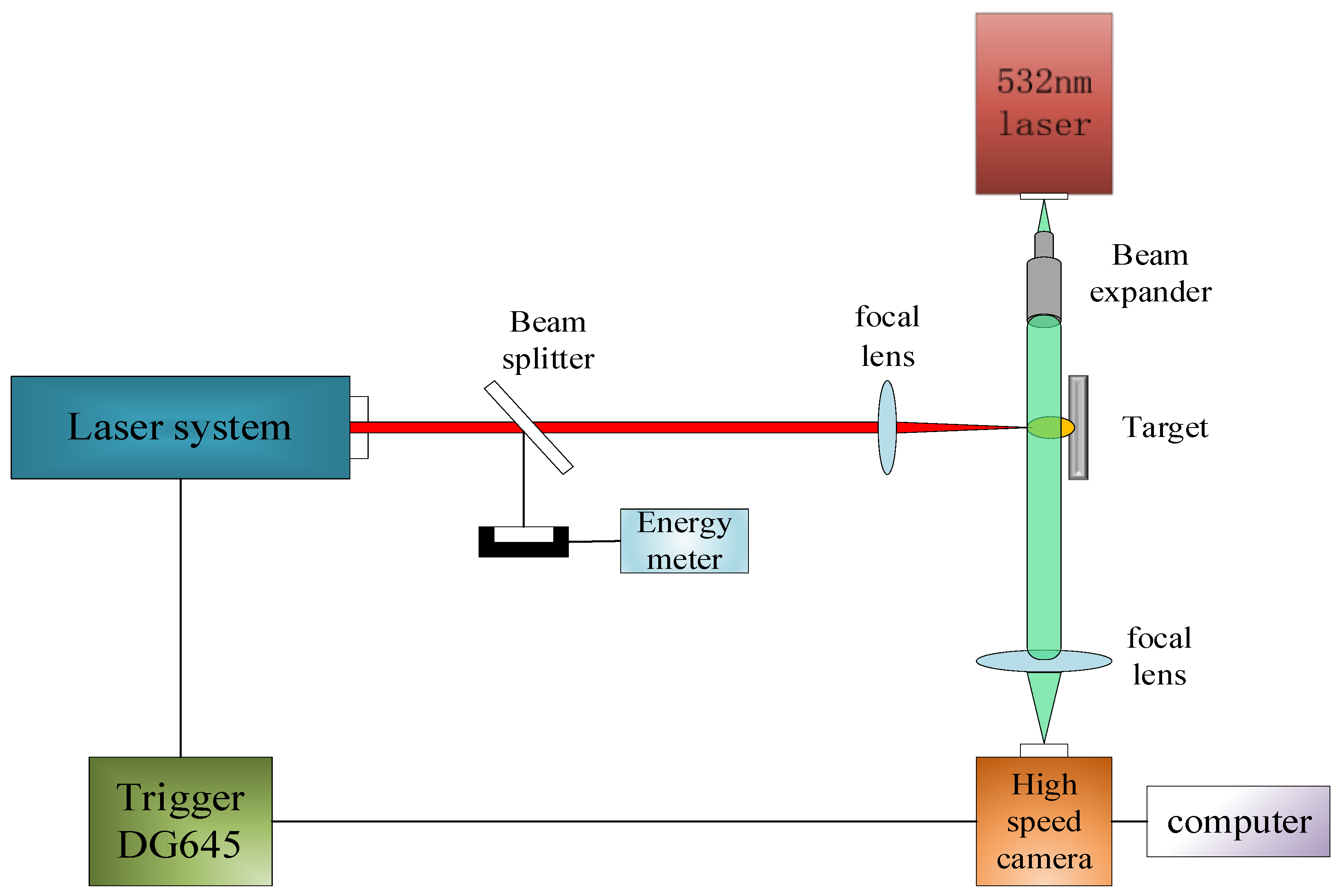
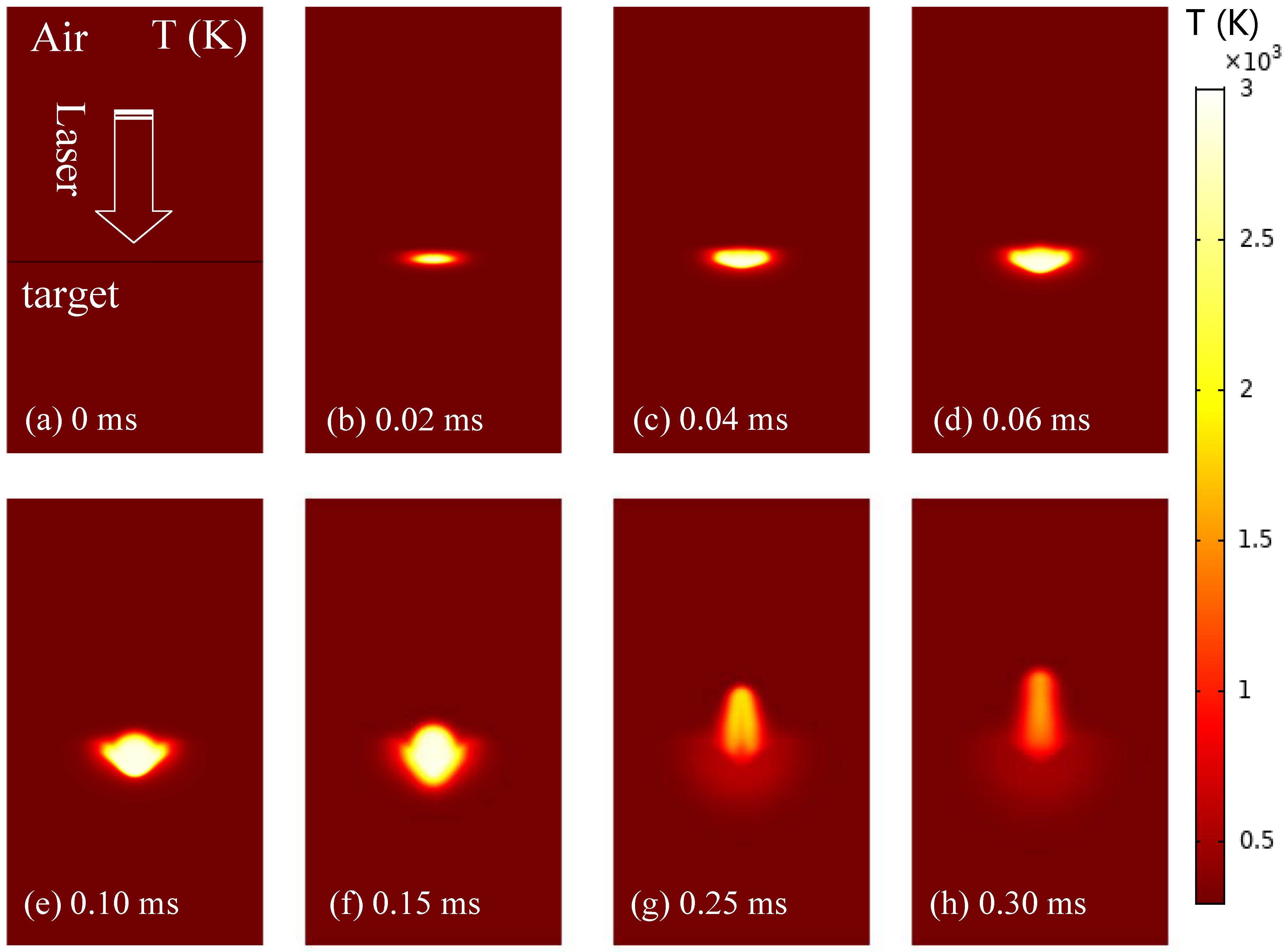
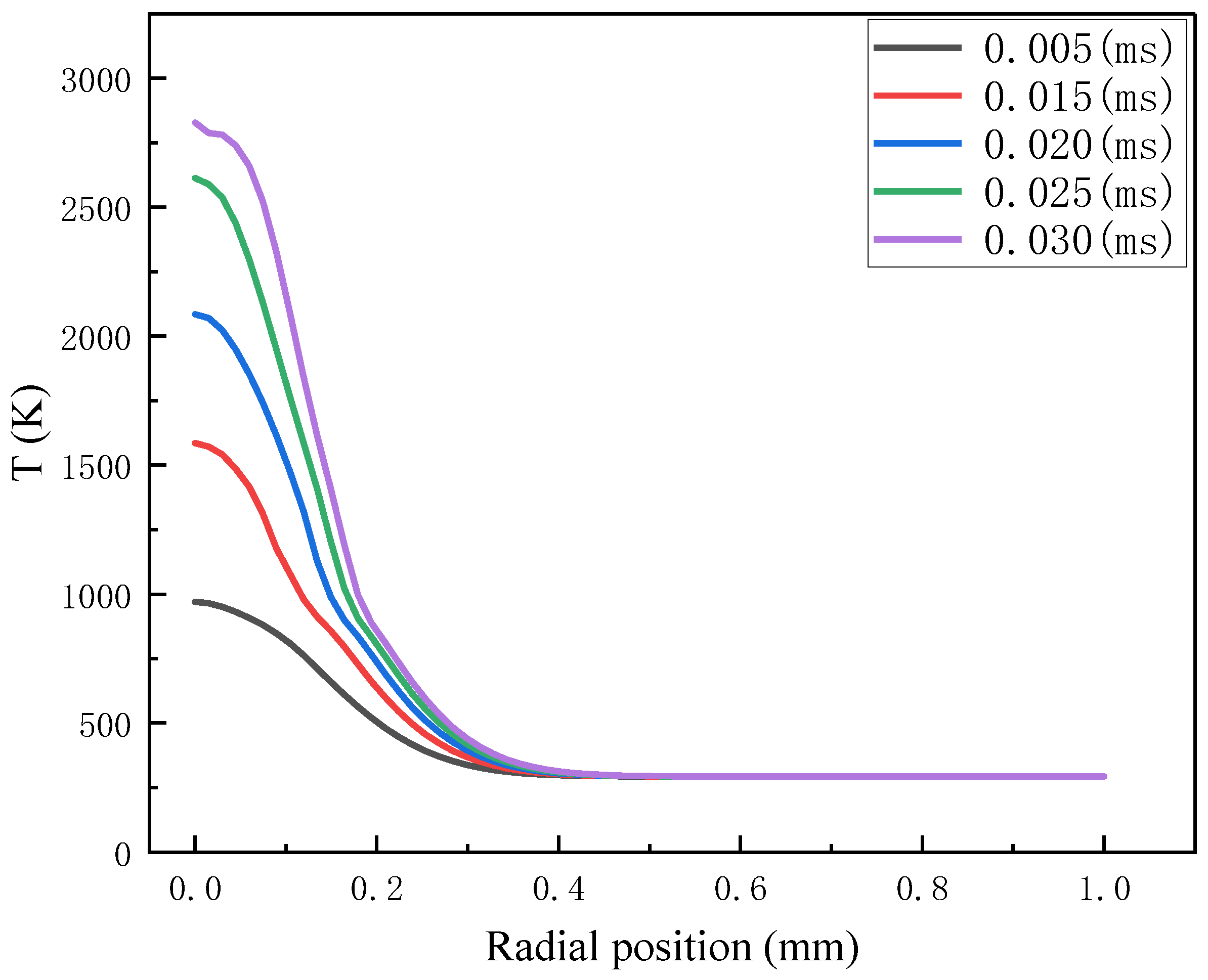
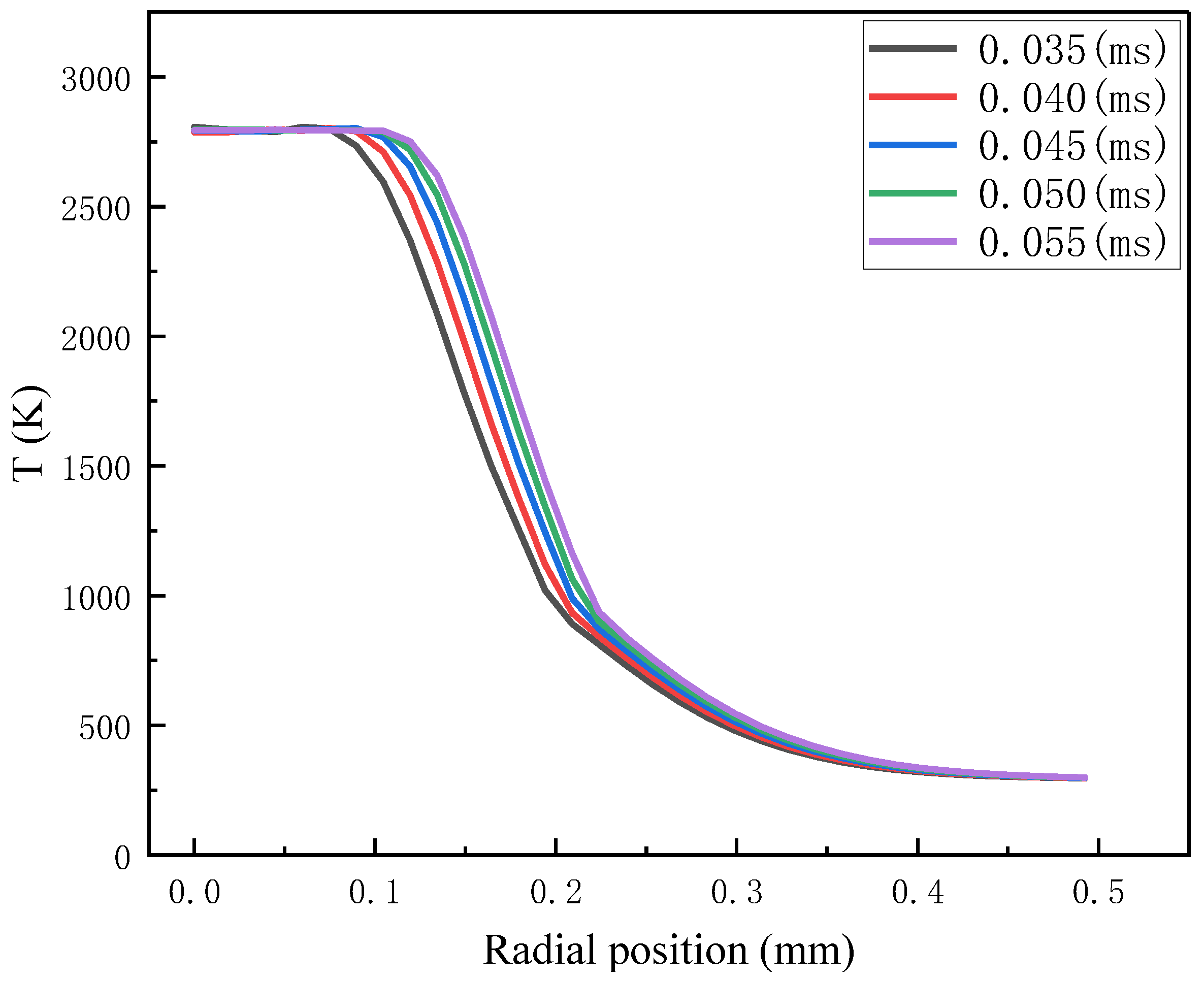
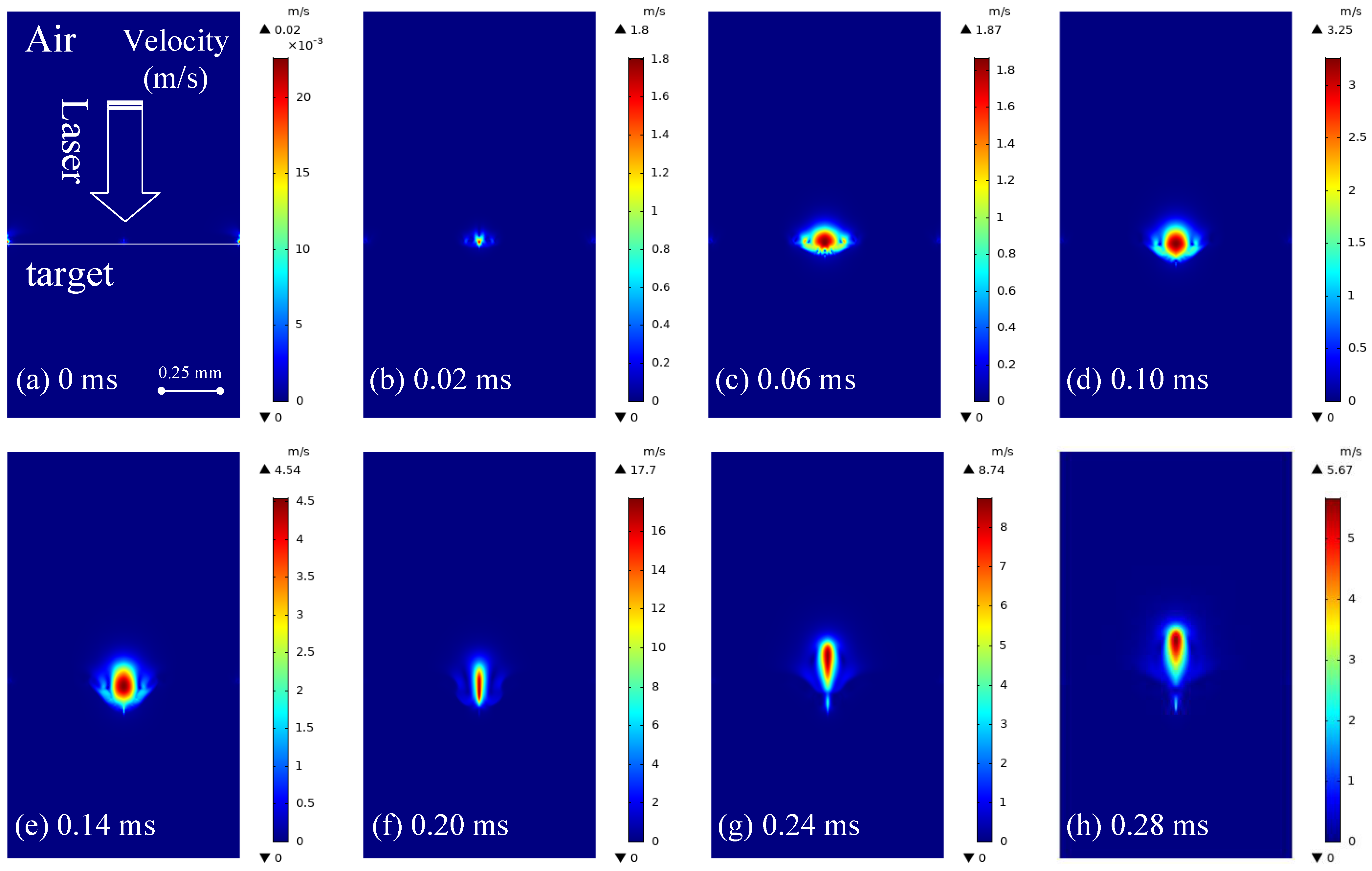
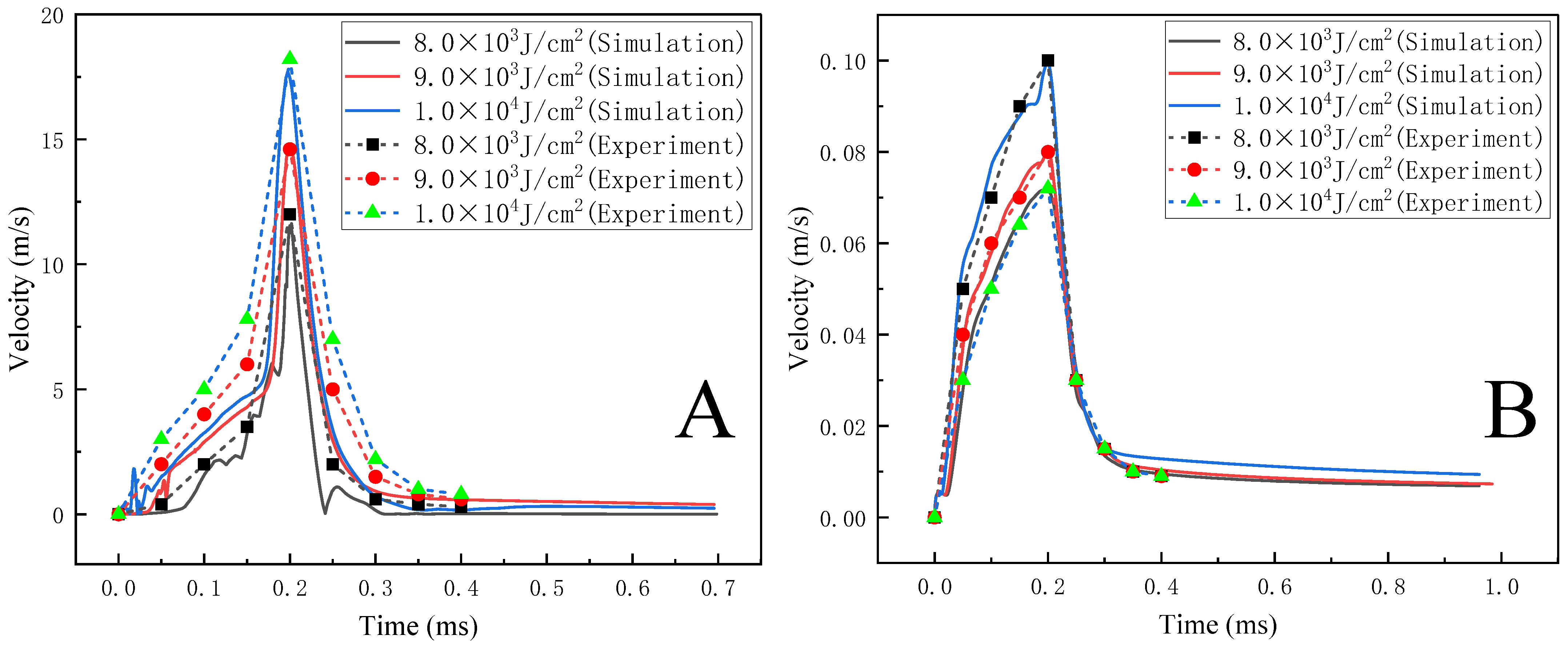
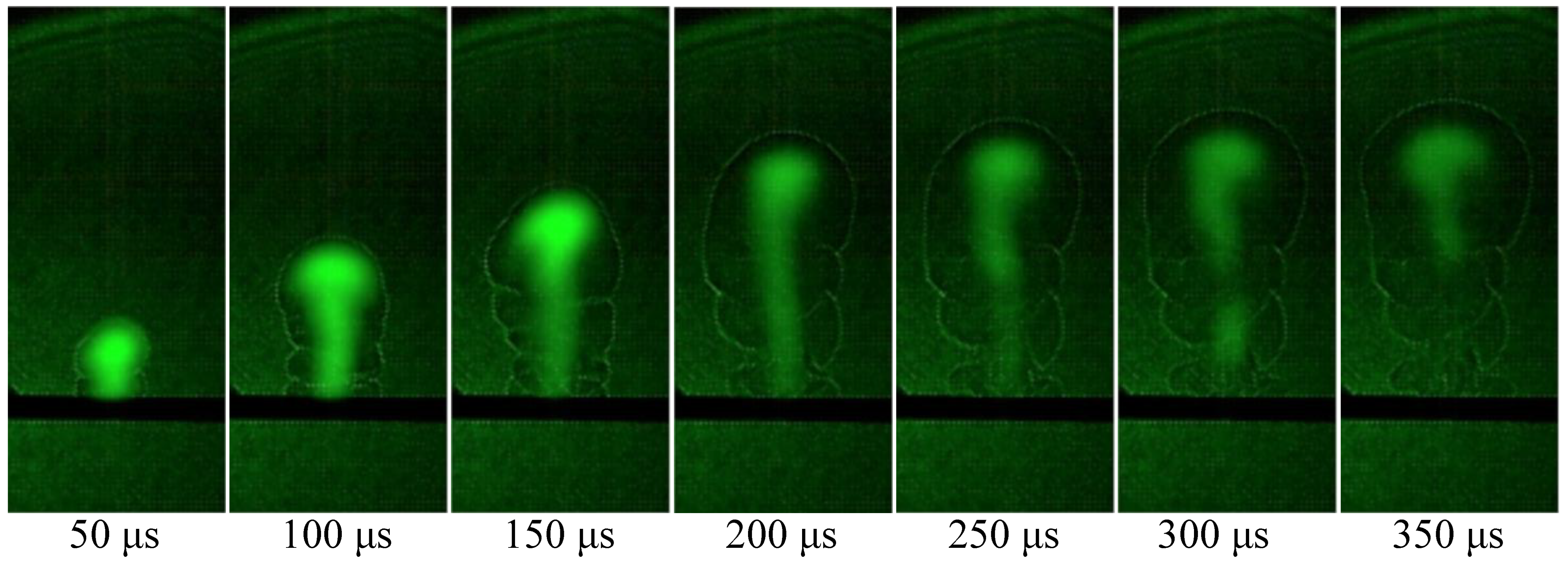
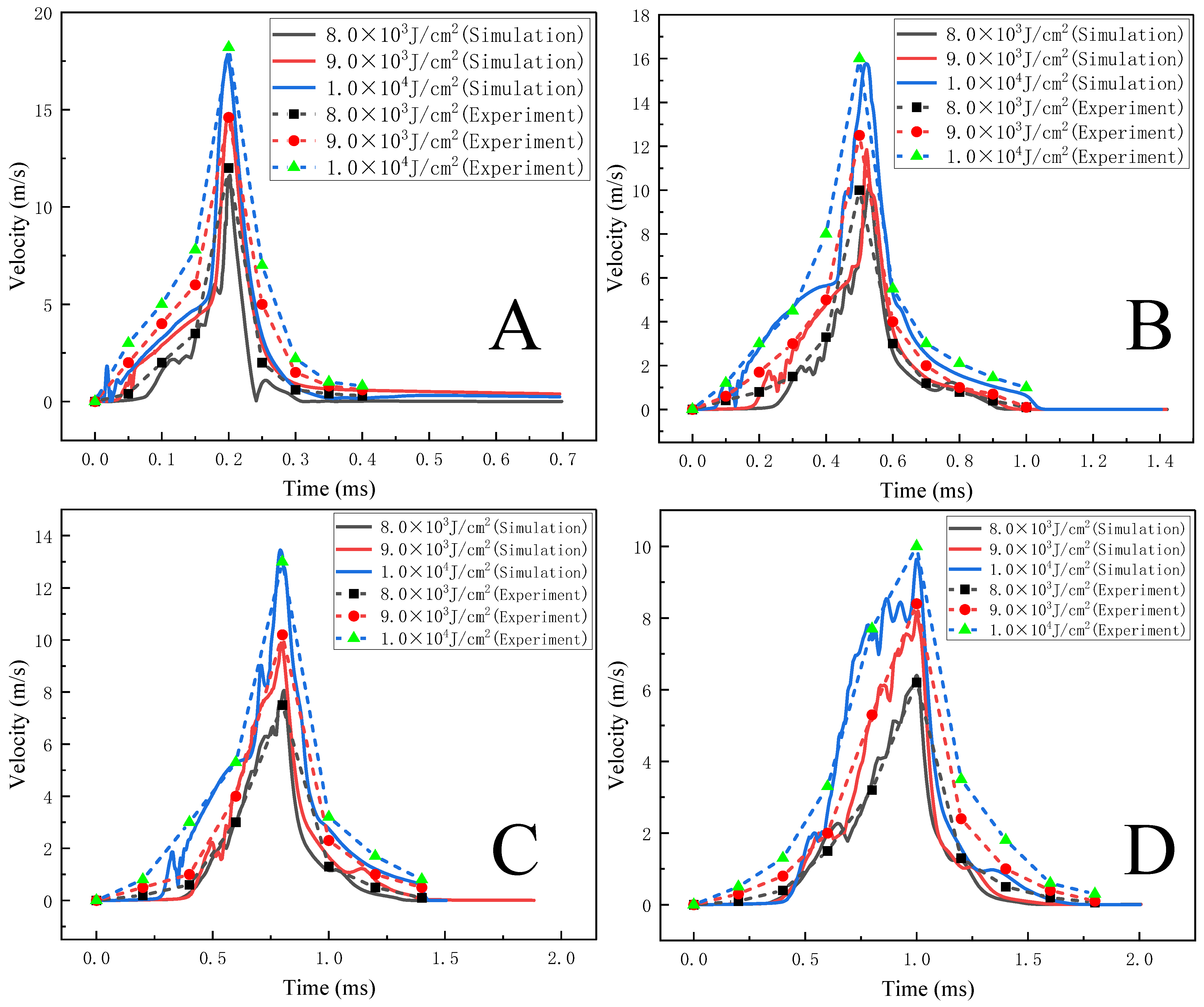
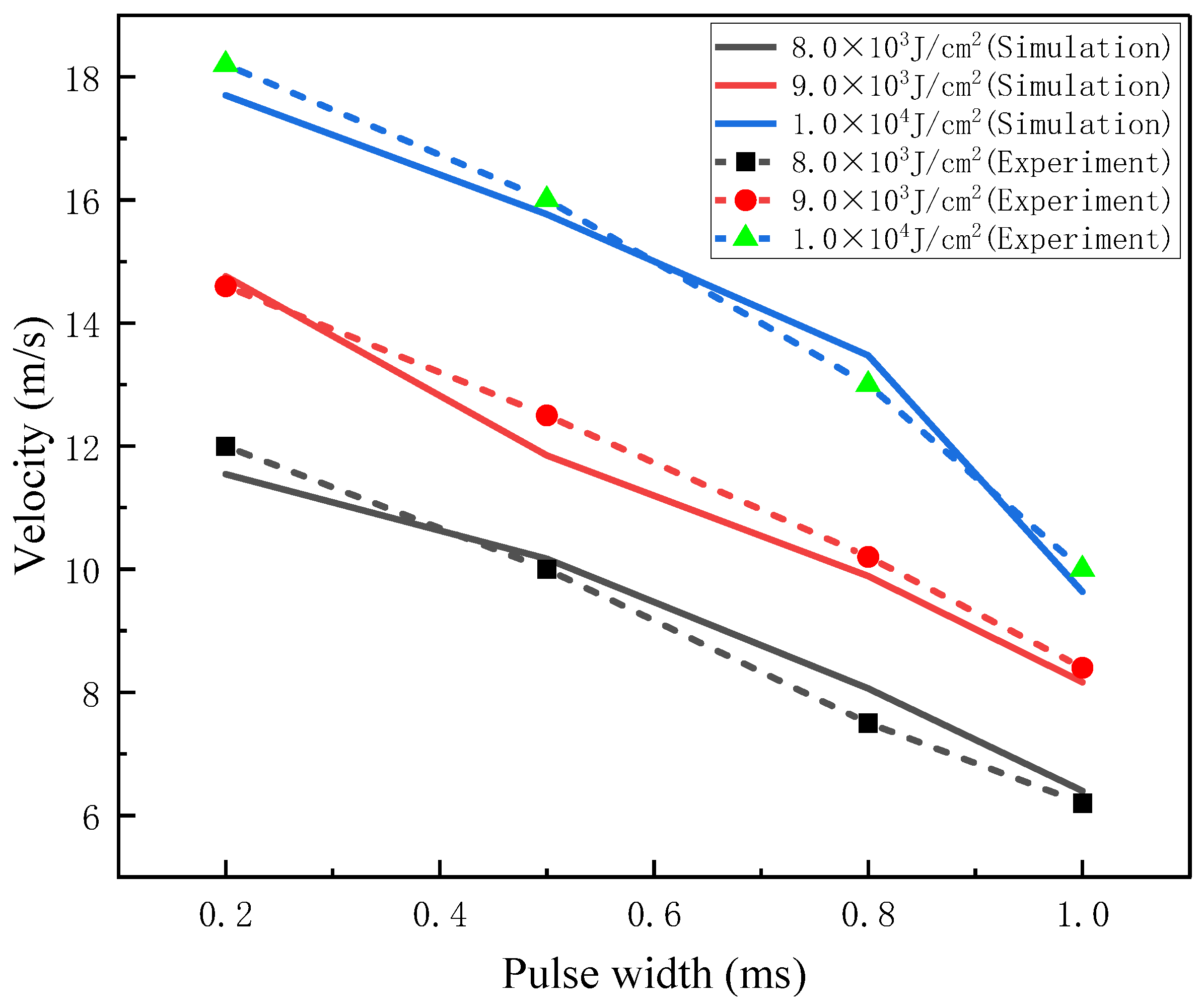
| Feature Parameter Name | Symbol | Numerical Value |
|---|---|---|
| Plasma Density | 3.49/T × 10−6 | |
| Plasma Thermal conductivity | −0.002 + 1.5 × 10−4 × T − 7.9 × 10−8 × T2 + 4.12 × 10−11 × T3 − 7.44 × 10−15 × T4 | |
| Plasma Heat capacity | 1047.27 + 9.45 × 10−4 × T2 − 6.02 × 10−7 × T3 + 1.29 × 10−10 × T4 | |
| Plasma Viscosity coefficient | −8.38 × 10−7 + 8.36 × 10−8 × T − 7.69 × 10−11 × T2 + 4.64 × 10−14 × T3 − 1.07 × 10−17 × T4 | |
| Melting point | 1730 | |
| Boiling point | 2503 | |
| Molar mass | 60 |
Publisher’s Note: MDPI stays neutral with regard to jurisdictional claims in published maps and institutional affiliations. |
© 2021 by the authors. Licensee MDPI, Basel, Switzerland. This article is an open access article distributed under the terms and conditions of the Creative Commons Attribution (CC BY) license (https://creativecommons.org/licenses/by/4.0/).
Share and Cite
Wang, L.; Sun, X.; Geng, C.; Zhang, Z.; Cai, J. A Study of the Characteristics of Plasma Generated by Infrared Pulse Laser-Induced Fused Silica. Crystals 2021, 11, 1009. https://doi.org/10.3390/cryst11081009
Wang L, Sun X, Geng C, Zhang Z, Cai J. A Study of the Characteristics of Plasma Generated by Infrared Pulse Laser-Induced Fused Silica. Crystals. 2021; 11(8):1009. https://doi.org/10.3390/cryst11081009
Chicago/Turabian StyleWang, Lixue, Xudong Sun, Congrui Geng, Zequn Zhang, and Jixing Cai. 2021. "A Study of the Characteristics of Plasma Generated by Infrared Pulse Laser-Induced Fused Silica" Crystals 11, no. 8: 1009. https://doi.org/10.3390/cryst11081009
APA StyleWang, L., Sun, X., Geng, C., Zhang, Z., & Cai, J. (2021). A Study of the Characteristics of Plasma Generated by Infrared Pulse Laser-Induced Fused Silica. Crystals, 11(8), 1009. https://doi.org/10.3390/cryst11081009






